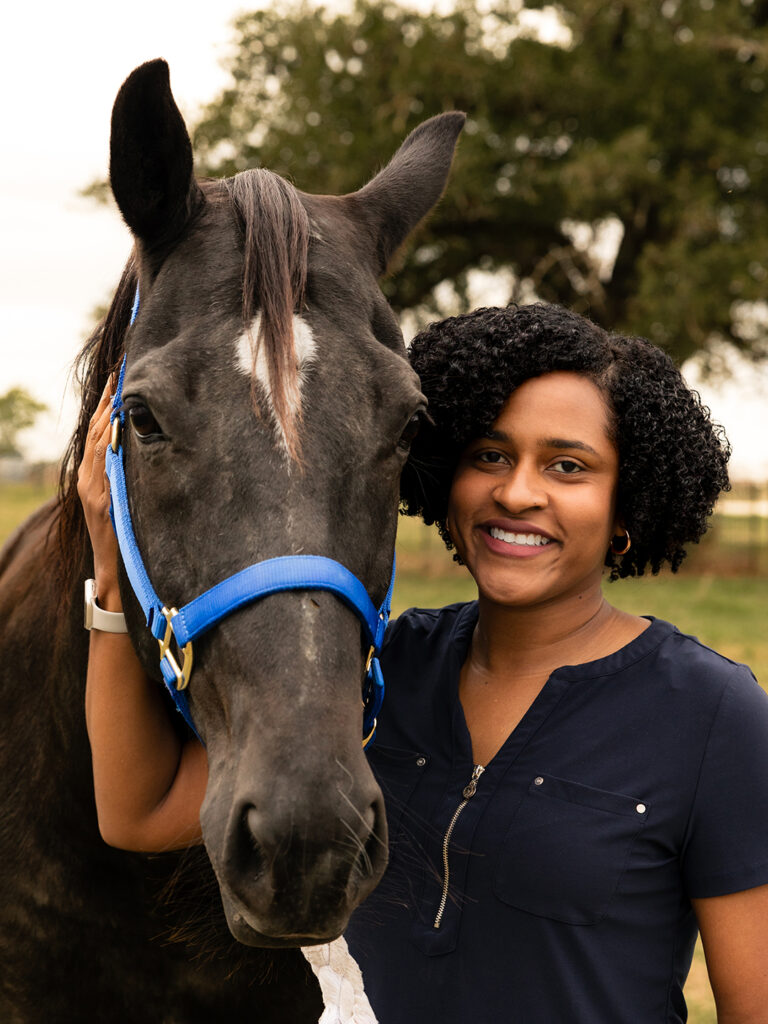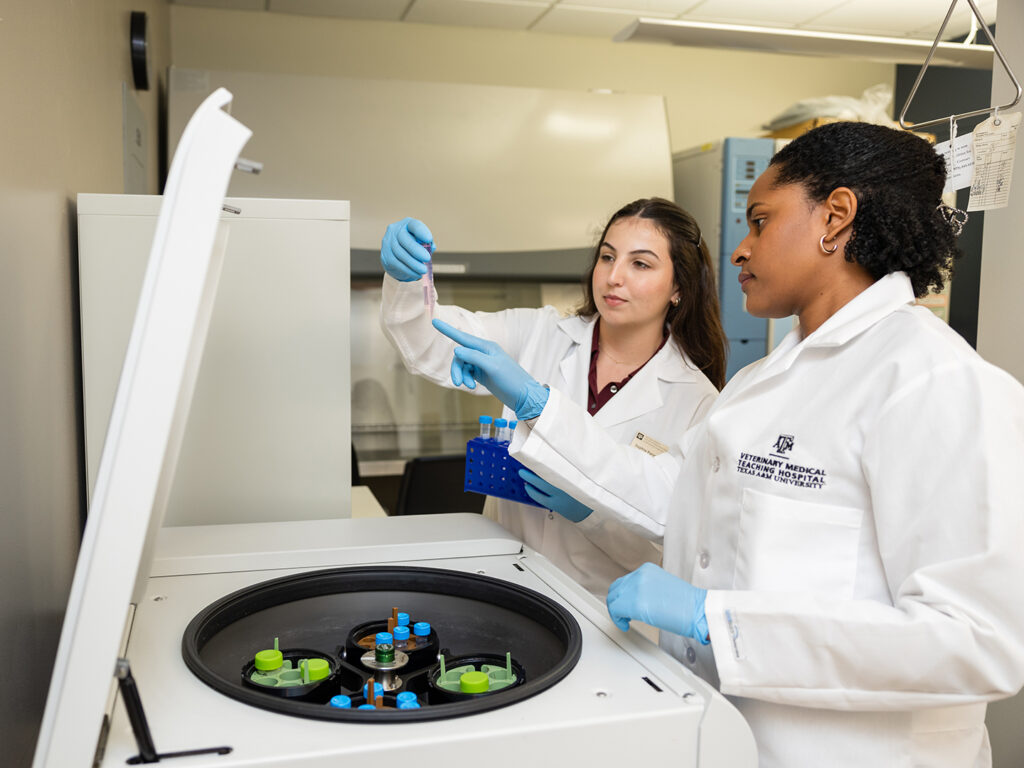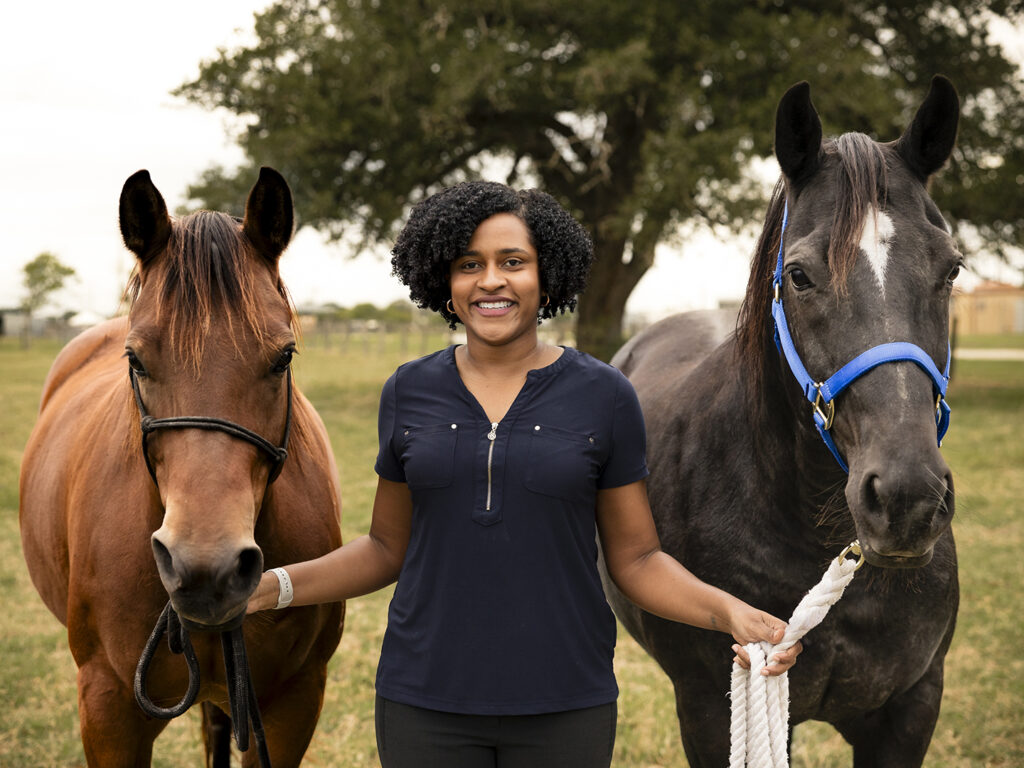Texas A&M’s New Theriogenologist Working To Solve Animal Reproductive Issues, Share Passion With Next Generation
Story by Courtney Price, VMBS Communications

Photo by Jason Nitsch ’14, Texas A&M University Division of Marketing and Communications
Animal reproduction is a complicated process that requires a perfect balance of many fertility variables. Most of the time, Mother Nature knows exactly what she’s doing; after all, animals have been reproducing for millions of years without human intervention.
But when certain variables — like having healthy sperm or a straightforward birth — don’t align, you may need to call in a theriogenologist like Dr. Yatta Boakari, an assistant professor and clinician in the Texas A&M School of Veterinary Medicine & Biomedical Sciences’ (VMBS) Large Animal Teaching Hospital (LATH).
As an animal reproduction specialist, Boakari primarily works to improve the reproduction capabilities of her patients, including large animals like horses and alpacas. Since animals can run into reproduction problems at many different stages in the process, Boakari’s expertise spans the entire reproductive journey, from conception to birth.
A Labor Of Love
Infertility can be a bigger problem for many animal species than people may realize.
“For males, the most common problem is poor semen quality,” Boakari said. “That can mean low numbers of sperm in the semen or abnormal movement. If that’s the case, we have different ways of processing and storing the semen that can help.
“With female animals, uterine infections and aging reproductive systems are the major problems,” Boakari explained. “Just like when women get older, animals can have trouble reproducing when they age.”
Boakari’s work has helped countless herd owners solve reproduction issues among their animals.
For example, Boakari previously helped an alpaca breeder who brought in one of his female alpacas to confirm whether she was pregnant. Boakari discovered that the alpaca was not pregnant and had endometritis, a disease in which there is a uterine infection. Thankfully, Boakari was able to treat the endometritis and the alpaca soon became pregnant.
While some reproductive problems inhibit animals from becoming pregnant, other issues impact their ability to give birth successfully.
“Most of the time animals give birth normally,” Boakari said. “But there is a problem called dystocia where they cannot do it by themselves. Dystocia is an emergency because it can lead to the death of the offspring and the mother.”
In addition to spending time with patients, Boakari also works on reproductive research. For example, she has helped debunk a harmful misconception about the kinds of diets that promote reproductive health in horses.
“A lot of people think a high-protein diet helps increase the fertility of mares,” Boakari said. “But during my Ph.D. research, we found a high-protein diet can actually lower the pregnancy rates in mares by causing changes to the uterus.”
The Makings Of A Mule

Photo by Jason Nitsch ’14, Texas A&M University Division of Marketing and Communications
Because infertility can happen at nearly every point in the reproductive process, it’s important that researchers and clinicians fully understand the complexity of female reproductive systems, especially animals that are still not well understood, like mules.
“One of my research collaborations with a group in Brazil looks at mules, horses, and donkeys to compare adult females and newborns across all three species,” Boakari said. “We want to understand how their reproductive systems and neonatal development differ since they have their own unique DNA.”
Since mules are bred from horses and donkeys, people often assume that they share the same physiology and treatment needs.
“We recently published research comparing newborn horses to mules,” Boakari said. “We wanted to see the exact times that they stood up for the first time, started nursing, and eliminated their first feces. These are important parameters for research and diagnosing problems. Many people just assume that mules have the same timeline, but we found that they’re actually different, with mule foals starting to nurse faster and taking longer to defecate.”
Even though female mules typically don’t give birth, specialized understanding of their reproductive systems is still important to their overall health.
“The number of mules in North America is steadily increasing,” Boakari said. “But for so long, we’ve neglected treating these animals as their own species for medical and reproductive purposes. We want to establish their baseline clinical signs so we can optimize their reproduction.”
Developing A Passion
These kinds of discoveries are perhaps what Boakari had in mind when she decided she wanted to become a veterinarian and, specifically, a theriogenologist.
But while Boakari had wanted to be a veterinarian since she was young, most people are surprised that veterinary medicine wasn’t the only career path that she considered.
“When I went to college, I wanted to try something different, so I pursued a bachelor’s degree in psychology,” Boakari said. “But finishing my psychology degree made me realize how much I still wanted to be a veterinarian. So, I went to vet school and focused on working with horses.”
During veterinary school at the Universidade Federal do Piauí in her native Brazil, Boakari decided she wanted to be a theriogenology professor. With the support of her parents, who are professors of sociology and pedagogy, and her sister, Boakari was able to navigate the long academic road toward her goal, which also included a doctoral degree in animal reproduction from the University of Kentucky.

Photo by Jason Nitsch ’14, Texas A&M University Division of Marketing and Communications
Boakari also had ample opportunity to work with a variety of animals through her residency and post-doctoral fellowship at Auburn University.
“I saw that they had a comparative theriogenology program and thought it would be important to know about more than one species,” Boakari said. “So, I applied and got to work with lots of farm and small animals, which really helped broaden my knowledge and gave me a lot of clinical experience.”
Working with a variety of animals is also one of the things that initially drew Boakari to Texas A&M.
“In some places, you are expected to work on one species or one group, like farm animals,” Boakari explained. “But here at Texas A&M, I get to work with all kinds of client animals and teaching animals. I really like the variety.”
It also doesn’t hurt that Texas has weather similar to Brazil.
“When I was at the University of Kentucky, it was really hard for me during the winter,” Boakari said. “My hometown is right on the equator, so I really prefer warm weather.”
It Takes A Village
In her current role, Boakari has many responsibilities, which include attending clinics, conducting research, teaching, and mentoring students.
“At the end of the day, teaching is my favorite part,” Boakari said. “I love the interaction with students — teaching, supporting, and learning with them. That’s where my psychology background really helps me, because I understand that veterinary students are in a very stressful situation. They have high class loads, lots of hands-on study, client-owner interactions, and the added stress of working with animals.”
Working with animals that may be suffering from health problems can be particularly stressful, since veterinarians care deeply about animal well-being. Add all of the stress of graduate-level education and you have a recipe for anxiety.
“One day a student on rotation with us came to me crying,” said Boakari. “She was having a really hard time managing all of her responsibilities. We talked, and I was able to help her with her time management and just see that everything was going to be OK. She went home to rest, and when she came back, she was able to enjoy the rotation.”
Boakari’s support for her students mirrors the support she receives from her amazing husband, family, and friends.
“Having a strong and supportive family has really helped me,” Boakari said. “They’re the reason I’ve come this far.”
###
Note: This story originally appeared in the Fall 2023 issue of VMBS Today.
For more information about the Texas A&M School of Veterinary Medicine & Biomedical Sciences, please visit our website at vetmed.tamu.edu or join us on Facebook, Instagram, and Twitter.
Contact Information: Jennifer Gauntt, Director of VMBS Communications, Texas A&M School of Veterinary Medicine & Biomedical Sciences; jgauntt@cvm.tamu.edu; 979-862-4216


